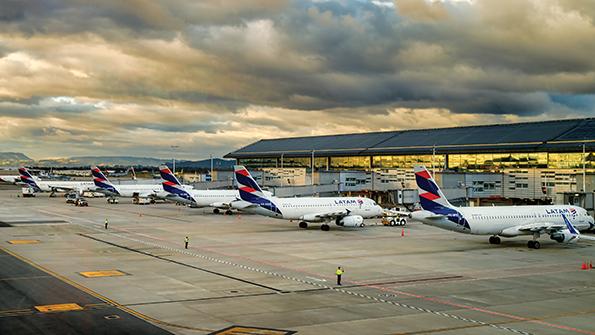
Airlines across Latin America and the Caribbean have continued to navigate their way back to health over the past year, expanding their networks, growing their fleets, and forging new partnerships with counterparts both inside and outside of the region.
Stronger performances from majors Aeromexico, Avianca and LATAM Airlines Group—which have each successfully emerged from US bankruptcy protection since the pandemic—helped to push overall traffic figures up by more than 28% in 2023, with most larger markets outstripping 2019 levels. The annual load factor for Latin America rose by 2.1 percentage points to 84.7%, according to IATA figures, making it the highest among all world regions.
“Latin American and Caribbean airlines have done a great job in reconnecting what was lost, as well as expanding within the region,” IATA regional VP-Americas Peter Cerda said. “We have also seen an influx of service from international carriers, leading to improved global connectivity.”
However, despite improvements, carriers collectively remain in the red. The region’s airlines faced overall losses of about $600 million in 2023, compared to a $3.9 billion loss in 2022, with a forecasted loss of $400 million in 2024. Brazil’s GOL Linhas Aereas is the latest to file for Chapter 11 due to an “unsustainable debt profile.”

Cerda acknowledged that it is a “complicated and frustrating” market with many regional differences that make regionwide profitability difficult. While countries such as Colombia, Ecuador and Mexico have adopted more proactive aviation policies to open their skies, others are increasingly mired in bureaucracy and turning to tax hikes and tariffs. Brazil is a case in point.
Although capacity in the Brazilian market has almost fully recovered, boosted by strong domestic and US demand, high fuel taxes, labor costs and legal liabilities make the country difficult for airlines, particularly new entrants. This is despite President Lula da Silva’s stated aim of increasing ultra-low-cost penetration so that air travel is within reach of more people, given the number of flights per capita stands at a lowly 0.4 trips per year. The lack of slots at São Paulo’s congested Congonhas Airport (CGH) is also an issue.
“The reasons why Lula hasn’t been successful is because of the bureaucratic conditions—it is costly to be profitable and competitive,” Cerda said. “The judicial system in the case of how it treats aviation is also the worst in the world. It is consistently putting punitive actions towards airlines—and that makes it very difficult for a ULCC to invest in the country.”
This point is echoed by José Ricardo Botelho, CEO of the Latin American and Caribbean Air Transport Association (ALTA). He highlighted that airlines are being held accountable for events beyond their control, such as storms and airspace closures, and called for action before “the country’s connectivity is unsustainably compromised.”
“Something is wrong when Brazil is the world leader in the number of lawsuits and a vulture side industry is encouraged to promote litigation, even though domestic carriers are recognized as among the most punctual on the planet,” Botelho said.
Cerda explained that a common theme affecting airline profitability—not just in Brazil but across Latin America—is that many governments still seek to impose themselves on aviation, highlighting Caribbean destinations where taxes and charges reach as high as 50% of the total ticket cost. Additionally, weakened currencies in several countries have made the cost of fuel—priced in US dollars—even more expensive, while competition from buses on “a very unfavorable platform” provides further headwinds for carriers.
“Our governments must understand and appreciate the importance of air transportation,” Cerda said. “If they acknowledge this, we can have an open discussion on a framework that will help airlines be successful, enabling them to grow and provide better service and more connectivity, while also reducing prices for more accessible travel and the shipment of goods. This, in turn, will help local economies flourish and make our airlines more profitable.”
LIBERALIZATION CALLS
Although political interference is nothing new in Latin America, Rafael Echevarne, director general of airports trade body ACI-LAC, stressed that the differing aviation policies with each new government remain one of the biggest challenges, citing several shifts that have occurred in recent years.
Mexico is a prime example, where President Andres Manuel López Obrador has implemented substantial changes since 2018. These include discontinuing the Texcoco airport project in Mexico City, reducing capacity at Benito Juarez International Airport (MEX) in preference for the newer but more remote Felipe Angeles International Airport (NLU), and launching the state-owned airline Mexicana. Further twists could come when Mexicans go to the polls in June.
Argentina—a country that has historically swung from liberalization to protectionism—is also facing a period of uncertainty after far-right outsider Javier Milei took office as president in December, pledging sweeping reforms to manage the country’s economic crisis. Since then, he has made declarations to privatize some state-run companies, including flag-carrier Aerolineas Argentinas, and potentially adopt an open skies regime.
Other nations, including the Dominican Republic, El Salvador, Panama and Uruguay, are also gearing up for elections this year that could have far-reaching implications for aviation.
Echevarne said these policy swings make it more difficult for airlines to plan with certainty, and, unlike other regions, governmental changes often result in a complete overhaul at a technical level. This causes a reset, requiring several years for the new team to grasp industry intricacies.
“We lack a supranational body similar to the European Union,” Echevarne said. “There are various organizations in Latin America and the Caribbean, such as CARICOM, UNASUR and the Andean Community, but these often have their own agendas with little joined up thinking.”
A key aim for ACI-LAC is to help stimulate intraregional air travel to better connect economies and regions, including increasing international links from secondary and tertiary cities. Analysis of OAG data for the upcoming summer 2024 season reveals 462 intraregional international routes are scheduled to operate within Latin America and the Caribbean during this period. While the geographical and political landscape differs significantly, this figure stands in stark contrast to the 6,400-plus intraregional international routes in Europe.
“While understanding the difficulties, challenges and politics involved, we look to Europe as an example of what we should aspire to—perhaps not full open skies, but the possibility of airlines flying between countries without including their own,” Echevarne said.
He added that the lack of international service from secondary destinations is “absurd when compared to other parts of the world.” Taking Peru as an example, the country has a population of about 33 million people, yet about 98% of its international traffic is via Lima. Likewise, almost 99% of international traffic passes through Chile’s capital Santiago.
“We aim to work diligently to convince governments and international organizations in the region to open up the market, regardless of its source, as long as it complies with all safety standards,” Echevarne said. “While it’s not as simple as waving a magic wand, there is a need for action within the region to promote liberalization.”
JetSMART CEO Estuardo Ortiz is among the airline leaders calling for greater freedoms to simplify airport access and regulations for foreign carriers. Speaking at a recent ALTA conference, he cited the requirement to have multiple air operator certificates (AOCs) in the “vast majority” of markets to operate there.
Alongside its main operation in Chile, JetSMART has subsidiaries in Argentina and Peru, with a new Colombian arm taking to the skies for the first time in March. Avianca, LATAM Airlines Group and Volaris are among the other groups with multiple AOCs.
“If we talk about smart regulations, the first thing we have to do to have more competition is to break down the barriers that do not allow you, as an operator from one country, to operate domestically in another country,” Ortiz said.
INFRASTRUCTURE CONSTRAINTS
Prioritizing investment in airport infrastructure will also be key to Latin America fulfilling its potential. A study completed by ACI World and Oxford Economics has found that airports need $94 billion in investments through to 2040 to meet the rising demand for air travel in the region, including $41 billion for greenfield projects.
“Unlike Europe, where road or rail options exist, in Latin America, you either go by plane or face treacherous roads, navigating through multiple passes that are thousands of meters high,” Echevarne said. “The choice is as straightforward as that—and so the airport sector is the key to competitiveness and international integration.”
Several countries have focused on expanding and modernizing existing airport assets, adding terminal capacity, and expanding aircraft aprons and runways. However, this has predominantly been in major cities where urban sprawl, combined with environmental and noise concerns, makes further expansion more difficult.
Additionally, investment is not coming quickly enough. Cerda praised the new terminal at Lima Jorge Chavez International Airport (LIM), which is scheduled to open later this year and push capacity to 30 million passengers per year, but said it was “around five or six years too late.”
He also stressed that government agencies must step up efforts to improve access to the airport.
“There is a major concern that we will have new infrastructure, basically a new airport, but won’t have a way to get there,” he said. “This has significant implications in a country that has a major hub.”
Investments in technology must also be made to make existing infrastructure more efficient and enhance the passenger experience. Echevarne highlighted the ongoing challenge of convincing leaders that the adoption of new technologies, such as biometrics, artificial intelligence and automation, to enhance processes like check-in, security and baggage handling, does not necessarily equate to job losses. Governments must also collaborate to improve air navigation systems and air traffic control to help make the best use of available capacity, he added.
While strides have been made in the recovery, many Latin American and Caribbean airlines continue to grapple with financial losses and regulatory hurdles. The call for liberalization, coupled with strategic infrastructure investments and technological advancements, remains essential for sustainable growth. A collective effort from governments will therefore be vital.





